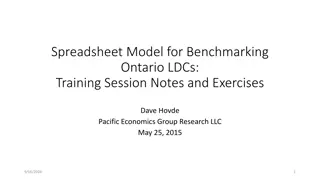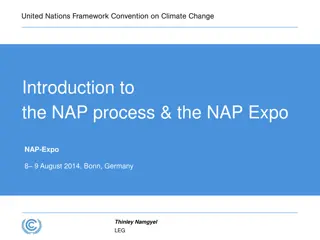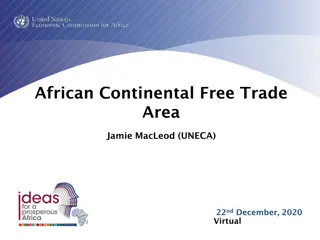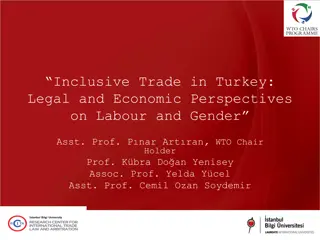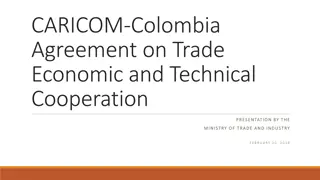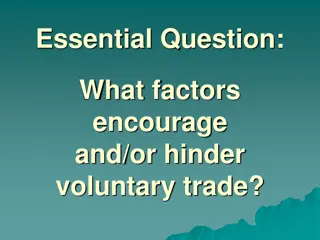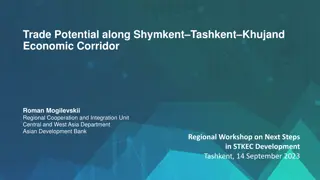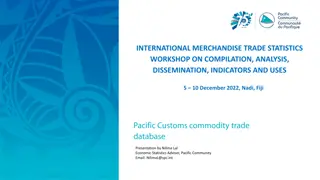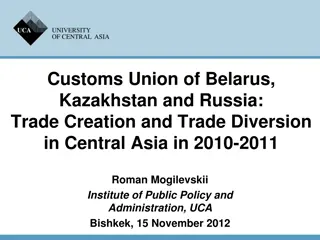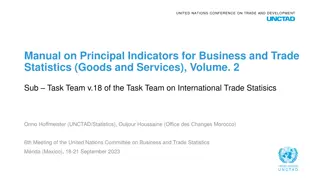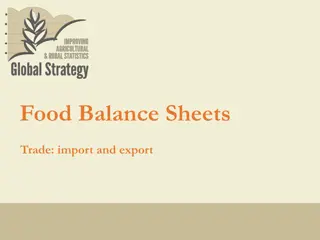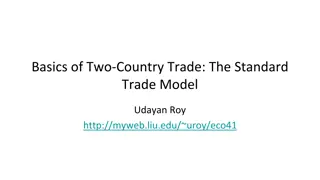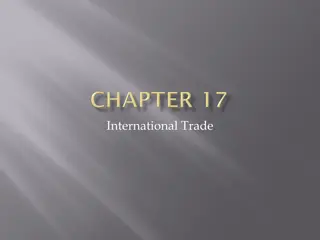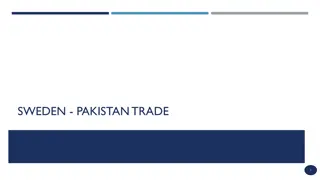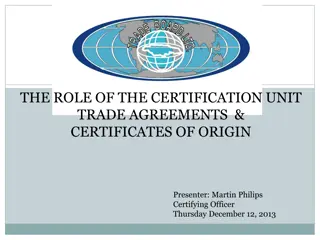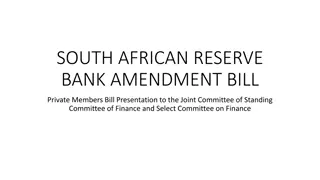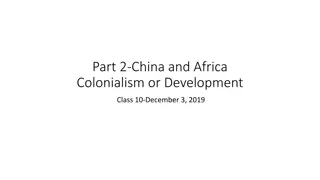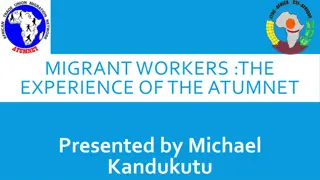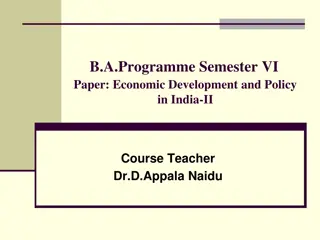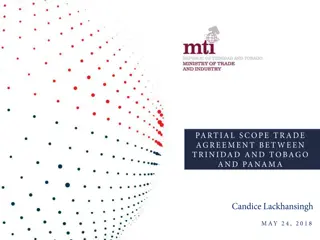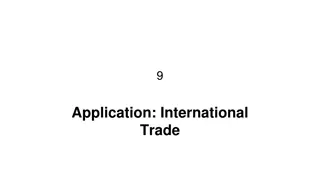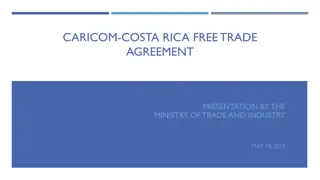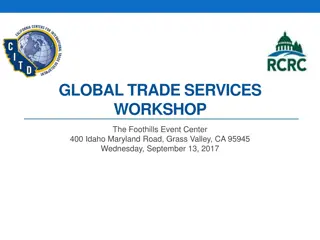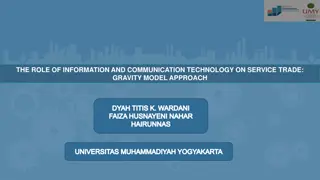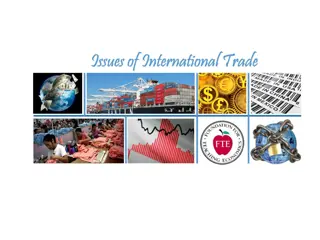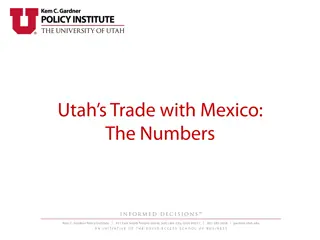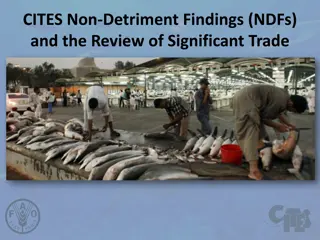Examining India's Trade Engagement with African LDCs
Delve into the simulation analysis of potential scenarios for an enhanced trade preference scheme between India and African Least Developed Countries (LDCs). The study scrutinizes the impact of India's preferential import regime on the exports and welfare of African LDCs, aiming to boost economic growth and foster stronger trade relations.
Uploaded on Sep 30, 2024 | 0 Views
Download Presentation

Please find below an Image/Link to download the presentation.
The content on the website is provided AS IS for your information and personal use only. It may not be sold, licensed, or shared on other websites without obtaining consent from the author. Download presentation by click this link. If you encounter any issues during the download, it is possible that the publisher has removed the file from their server.
E N D
Presentation Transcript
Deepening Indias Engagement with African LDCs A simulation analysis of alternative scenarios for an enhanced and expanded trade preference scheme Rajesh Chadha Senior Fellow March 10, 2014
Outline of Presentation Backdrop Objectives Present Scenario Simulation Analysis Concluding Remarks
Backdrop The Hong Kong WTO Ministerial (2005) Developed countries to extend Duty-Free Quota-Free (DFQF) to LDCs Developing countries expected to do so according to their capacity India became the first developing country Duty Free Tariff Preference Scheme for LDCs (DFTPI-LDC) in 2008 Expectation was to boost exports and GDP of LDCs This study looks at African LDCs (AFLDCs)
Outline of Presentation Backdrop Objectives Present Scenario Simulation Analysis Concluding Remarks
Objective of the study To analyse the potential and the actual impact of India s preferential import regime on the exports and welfare of Africa s Least Developed Countries (LDCs). Approach: Study the structural change in AFLDCs exports to India since 2005 Estimate the potential benefits for AFLDCs using a computable general equilibrium (CGE) model of the world economy.
Real GDP Growth (%) Average 2002-08 2009 2010 Average 2009-2012 Forecast 2013 2011 2012 LDCs 7.5 5.0 5.6 4.5 5.3 5.1 5.7 AFLDCs 7.5 4.2 4.9 4.4 4.8 4.6 5.6 Developing 7.6 2.7 7.6 6.4 5.1 5.5 5.3 Advanced 2.5 -3.5 3.0 1.6 1.2 0.6 1.2 WORLD 4.7 -0.6 5.2 4.0 3.2 3.0 3.3 Source: The LDCs Report 2013, UNCTAD
India's imports from AFLDCs (million USD) Year Oil Non-oil Total 2007 1,696 805 2,501 2008 1,939 1,329 3,268 2009 3,660 1,262 4,922 2010 5,300 1,175 6,475 2011 5,989 1,979 7,969 2012 8,713 2,590 11,302 Source:Calculations based on WITS online database.
Share of imports from AFLDCs in imports from Africa (%) Year Oil Non-oil Total 2007 16.4 10.4 13.8 2008 14.0 10.9 12.5 2009 30.2 14.6 23.7 2010 26.5 10.8 21.0 2011 25.5 12.5 20.3 2012 31.9 16.4 26.3
Share of imports from AFLDCs in imports from all LDCs (%) Year Oil Non-oil Total 2007 54.0 29.1 42.3 2008 74.3 35.7 51.6 2009 77.5 36.7 60.3 2010 71.6 32.2 58.6 2011 89.4 40.4 68.7 2012 92.7 47.1 75.9
Indias import in major categories from AFLDCs (million USD) Category Petroleum Oils Vegetable Products Base Metals & Articles Thereof Mineral Products Chemical Products Textiles & Textile Articles Pearls, Precious Or Semi-Precious Stones, Metals Others Total Imports 2008 1,939 439 182 292 175 101 2012 8,713 824 555 465 346 130 30 126 143 105 3,264 11,302 Source:Calculations based on WITS online database (6-digit tariff lines mapped to GTAP)
Indias DFTP Scheme for LDCs (2008-2012) Duty Free items: On about 85 per cent of India s total tariff lines, applied customs duty have been removed over a period of 5 years with 20 per cent reduction each year. Positive List: In addition to the 85 per cent duty free tariff lines, preferential market access as per Margin of Preference (MOP) is available on about 9 per cent tariff lines (458 items). The MOP ranges from 10 per cent to 100 per cent on different items and is available on the applied rate of duty as on the date of imports. Exclusion List: contains only 6 per cent of total tariff lines (326 items) on which no tariff preference is available and imports are allowed at MFN rates.
Outline of Presentation Backdrop Objectives Present Scenario Simulation Analysis Concluding Remarks
Imports from Major AFLDCs (Average for 2009-2011, '000 USD) Countries Angola Senegal Tanzania Guinea Benin Guinea-Bissau Zambia Togo Equatorial Guinea Mozambique Congo, Dem. Rep. Total Oil Non-oil 27,673 267,056 259,526 88,141 179,136 133,400 110,087 99,661 294 84,284 8,985 1,467,049 Total 4,746,053 267,056 259,526 182,336 179,136 171,874 110,087 99,661 89,398 84,284 51,890 6,450,108 4,718,380 - - 94,195 - 38,474 - - 89,104 - 42,905 4,983,058 Source:Calculations based on WITS online database (total value in declining order)
Shares of preferences across countries, excluding oil (2009-2011, %) Countries Senegal Tanzania Benin Guinea-Bissau Zambia Togo Guinea Mozambique Malawi Madagascar Angola Excluded 92.9 9.3 19.2 1.9 13.5 59.3 13.7 6.2 3.2 31.4 95.9 Positive 0.2 38.7 2.4 0.1 0.4 5.0 0.2 48.8 95.8 52.9 0.0 Duty Free 6.9 52.0 78.4 98.1 86.1 35.6 86.1 45.0 1.0 15.8 4.1 Total 100.0 100.0 100.0 100.0 100.0 100.0 100.0 100.0 100.0 100.0 100.0 Total (All AFLDCs) 32.5 15.9 51.7 100.0 100.0 6% lines 9% lines 85% lines Source:Calculations based on WITS online database.
Outline of Presentation Backdrop Objectives Present Scenario Simulation Analysis Concluding Remarks
General Equilibrium Modelling Analysis The Global Trade Analysis Project (GTAP) model is Multi-region, multi-sector computable general equilibrium (CGE) mode Analyses the trade flows across countries/ regions of the world Each country/ region is divided into sectors of production Inter-linkages across sectors captured through input- output databases
GTAP Database GTAP version 8.1 database has 57 sectors of production 14 agriculture etc.; 5 minerals; 24 manufacturing; 14 services 134 countries / regions including 17 AFLDC countries / regions
Policy Simulation Assess the potential gains to AFLDCs under two scenarios: I. Partial Liberalisation: India liberalising its applied tariffs on positive and duty free lists products (excluding services). Restricting Exclusion List products. II. Complete Liberalisation: India liberalising its applied tariffs for all categories of imports (excluding services).
Closure Rule Modifications in the standard GTAP book closure to capture the issue of employment in AFLDCs: Underemployment of unskilled labour in AFLDCs. Dropped the full-employment assumption for unskilled labour. The real wage is fixed exogenously. Supply of unskilled labor is determined endogenously.
Outline of Presentation Backdrop Objectives Present Scenario Simulation Analysis Concluding Remarks
Results The welfare change is positive for all AFLDCs under partial liberalisation, increases further under complete liberalisation. The major gaining countries/ regions: Benin, Rest of West Africa and South Central Africa. The extent of increase in welfare gain under complete liberalisation scenario may relate to how much share of imports was under excluded list.
Results Important examples: Senegal: 10% partial; 63% complete Additional 53%: phosphoric and polyphosphoric acid which fell under the excluded list gets opened up for duty free market access Madagascar: 51% partial; 99% complete Additional 48%: ferrous waste and scrap; refined copper wire which fell under the excluded list gets opened up for duty free market access
Results The total welfare of AFLDCs increase by: $1,008 million under partial liberalisation $1,201 million under complete liberalisation India loses welfare worth: $144 million under partial liberalisation $171 million under complete liberalisation World gains welfare worth: $469 million under partial liberalisation $561 million under complete liberalisation
Results The real GDP increases for all AFLDCs The major gainers under complete liberalisation: Benin, Togo, Rest of West Africa followed by Guinea, Madagascar and Uganda The exports to the world increase for all AFLDCs except for Benin AFLDCs gain in terms of trade
Results The factors of production also gain. The returns to land increases in all AFLDCs. The returns to capital and skilled labour also increase except for Madagascar, Mozambique, Rwanda and Tanzania - production structure moves in favour of land intensive goods.
Results India s sectors of production get affected due to its DFTP Scheme The output declines: paddy and rice; vegetables, fruits and nuts; other crops; cattle, sheep and horses; forestry; and crude oil. India s exports of all sectors increase expect for gas.
Results Exports of major commodities increase when India provides DFQF market access to AFLDCs. Exports of all the AFLDCs except Rwanda increase. The gains are expected to be higher if commodities under the excluded list are also made duty free.
Mapping of Model Regions with GTAP Region Country/Region India Rest of West Africa Benin Burkina Faso Guinea Togo Central Africa South Central Africa Senegal Ethiopia Madagascar Malawi Mozambique Tanzania Uganda Zambia Rwanda Rest of East Africa Code India RWAfrica BEN BFA GIN Togo CentAfrica SCAFRICA SEN ETH MDG MWI MOZ TZA UGD ZAM RWA RestEAfrica GTAP Sectors India Rest of West Africa (XWF) Benin Burkina Faso Guinea Togo Central Africa (XCF) South Central Africa (XAC) Senegal Ethiopia Madagascar Malawi Mozambique Tanzania Uganda Zambia Rwanda Rest of Eastern Africa(XEC)
List of AFLDCs exporting top 50 HS 6-digit products to India 6 Digit HS Code 280920 720449 251020 760200 740400 740311 090111 720410 271019 120740 271011 120799 720429 090240 080132 720421 130120 740811 720441 720430 Description Phosphoric acid and polyphosphoric acids Ferrous waste and scrap nesi Natural calcium phosphates Aluminium, waste and scrap Copper spent anodes; copper waste & scrap Refined copper cathodes and sections of cathodes Coffee Cast iron waste and scrap Distillate and residual fuel oil (including blends) Sesame seeds Light oil motor fuel Oil seeds and oleaginous fruits Alloy steel (o/than stainless) waste and scrap Black tea Cashew nuts Stainless steel waste and scrap Gum Arabic Refined copper, wire Ferrous turnings, shavings, chips Tinned iron or steel waste and scrap Countries Senegal Angola, Senegal, Guinea, Madagascar, Benin Togo Benin, Senegal, Angola, Tanzania, Togo Benin, Zambia, Angola, Tanzania, Liberia Zambia, Tanzania Uganda, Guinea Tanzania, Benin, Angola, Mozambique Tanzania, Liberia, Mali Somalia, Ethiopia, Tanzania, Burkina Faso Liberia, Tanzania Benin, Ethiopia, Burkina Faso, Burundi Togo, Benin, Sierra Leone, Senegal, Liberia Malawi, Tanzania, Mozambique, Senegal Tanzania, Mozambique Angola, Benin, Eritrea, Tanzania, Togo Ethiopia. Tanzania, Guinea, Mali, Togo Zambia, Malawi, Tanzania, Madagascar Benin, Senegal, Togo Madagascar, Angola, Senegal, Guinea, Eq. Guinea
Outline of Presentation Backdrop Objectives Present Scenario Simulation Analysis Concluding Remarks
Outline of Presentation Backdrop Objectives Present Scenario Simulation Analysis Concluding Remarks


